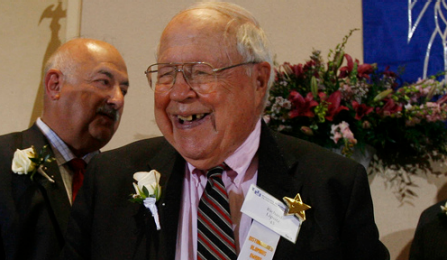Richard Lipsitz ’43 recalls a storied career in employment law

Looking back on his career, Richard Lipsitz ’43 says, “I finally came to the point where I realized that I owe a lot of my success in my life and my career to the Law School, and it was a sensible thing to leave some money to it.”
There was a job waiting for Richard Lipsitz as soon as his Law School education was complete. In fact, the school allowed him (and others) to finish in 2½ years – taking classes over the summer – so he could graduate in December 1942 and get on with it.
But he was destined for no law firm. A member of the U.S. Army Signal Corps Reserve, he was headed for combat as World War II shifted to the Pacific Theater. When the atomic bombs were dropped on Hiroshima and Nagasaki, Lipsitz was training with his fellow soldiers in California, getting ready to ship out to the Philippines as part of an expected invasion of Japan.
Instead, he served in Japan as part of the occupation Army. Military service delayed his entry into the legal profession by more than three years.
He made up for the late start with a long and storied career – more than half a century primarily spent representing labor unions. He remains of counsel with the Buffalo firm that bears his name, Lipsitz Green Scime Cambria.
During that time he defended individuals accused of being Communists by the House Un-American Activities Committee (a “traveling circus,” he says), represented Vietnam War protesters and draft dodgers, and advocated for civil rights with the American Civil Liberties Union and the Coalition for Economic Justice. He took two cases to the U.S. Supreme Court; in one, he prevailed when a sharply divided court struck down a New York State law that required teachers in public institutions to swear their loyalty to the United States.
Now, in recognition of the foundations laid for his career by what’s now SUNY Buffalo Law School, Lipsitz has pledged a bequest of $50,000 in support of the Legal Analysis, Research and Writing program, in which his daughter, Nan Haynes, teaches. (Lipsitz and his wife, Rita, a retired UB staff member, have three grown children; two of them have SUNY Buffalo Law degrees, as does one grandchild.)
The Buffalo Law School of the 1940s was a different place, Lipsitz notes. He remembers walking from the Eagle Street classroom building to the downtown courts to watch lawyers argue their cases – sometimes, he admits, even skipping a class or two to do so. Moot court and mock trial opportunities were rare then, he says, so the working courts were an education in themselves. And his class was decimated by the wartime draft and those who left school to volunteer for military service.
But he also remembers with satisfaction the rigor of his Law School courses, taught mostly by the Socratic method. “It was a very interesting method of teaching,” Lipsitz says. “It made me prepare, that’s for sure.
“The faculty that taught me and my class was mostly sent from Harvard to be trained as law professors and eventually returned to Harvard Law School,” he says. “It was an exceptional faculty, and I got a great education. I have that to thank the Law School for.” He also took courses in labor law and workers’ compensation law, feeding his long-held interest in the labor movement.
Looking back on his career, Lipsitz says, “I finally came to the point where I realized that I owe a lot of my success in my life and my career to the Law School, and it was a sensible thing to leave some money to it."